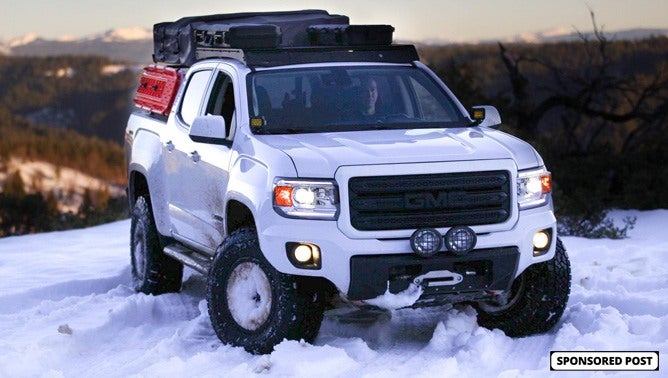We delivered a set of Toyo Open Country A/T III Tires to one lucky forum user, Justin Wages, for him to put to the test on his GMC Canyon. Over the course of a year, Justin pushed the tires to the limit on trails, rough terrain, mud, snow, and anything else he could find. Here are his thoughts.
My Take
What do you do when that new-tire romance has run its course and the honeymoon phase is over? Well, you write up a long-term review of the tire and detail your experiences good and bad, that’s what you do!
I’ve spent roughly a year and all four seasons driving around in my “overland build” 2018 GMC Canyon 4×4 on the redesigned Open Country A/T III by Toyo Tires. As my daily driver and adventure rig, I have truly put these round & black traction miracles through the paces. 12,000 miles later here are my thoughts.
I use this truck for normal daily driving duties but it also serves as my transport of choice for much wilder places like slickrock of Moab, the snowy/rocky trails of the Sierra Nevada, the shelf-cut shale trails of Colorado and the fast, cactus-lined, whoop filled trails of the western deserts. As such I need a tire that can get me and my family to these destinations comfortably and safely regardless of what weather conditions we encounter. THEN the tire needs to offer great off-road traction, predictability, and durability in challenging trail conditions.
As a recap to my “First Impressions Review”; I opted for a C Load Rating this time around instead of my usual choice of E Load Light Truck (LT) tire. Mid-sized trucks are somewhat of a “tweener”. They are not light enough to get away with the typical P-metric or passenger style tire but they are not heavy enough to warrant the use of a super heady duty E Load LT tire. Unfortunately very few manufactures offer an LT285/70/17 in a C Load rating that I would want to run on my truck. So in the past if I wanted the durability and deeper tread depth of an LT tire I was stuck with an E Load which isn’t necessarily a bad thing but those higher load ratings bring unwanted weight, price and generally feel rougher on road. They also deform less when aired down for off-road traction and comfort.
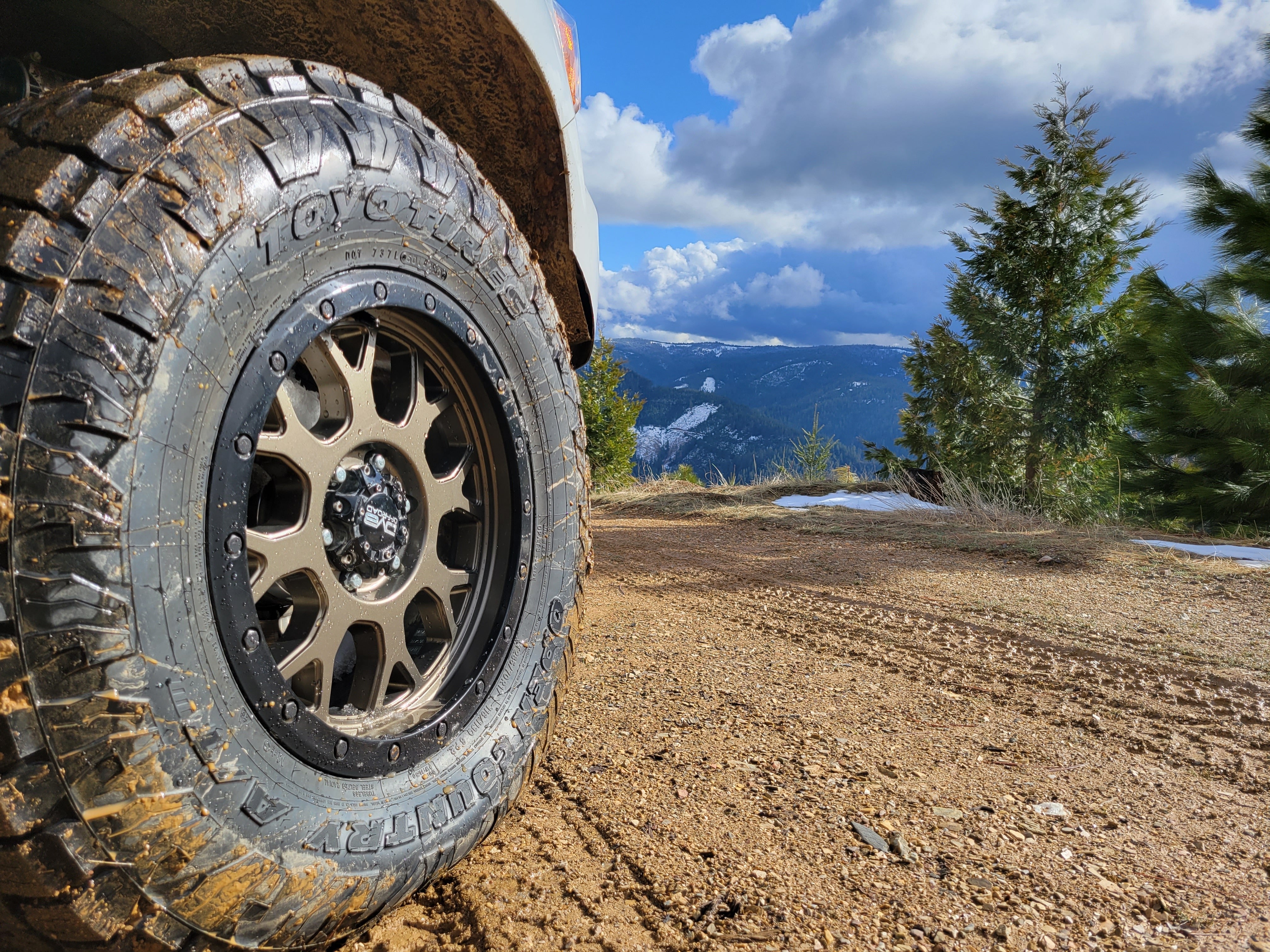
Appearance – Toyo Tires knocked it out of the park with the appearance of this tire. I’ll admit it. I’m a bit of tire snob and I will not mount a weak-looking tire on my rig regardless of its trail cred. We all love looking at our trucks and some of us take way too many pictures of them. Some go even further and post photos of their trucks on social media so we err I mean those nutty people want a tire that looks legit. With an aggressive (and functional) sidewall design coupled with moderately spaced traction blocks the Toyo Tires looks more like a modern hybrid between all-terrain and mud terrain than the average all-season focused all-terrain tire of the past.
Comfort/Noise –In the past I’ve ran a number of the top 5 all-terrain tires on this truck including one mud terrain and I find the Toyo Open Country A/T III to be the perfect balance between comfort and off-road grit. They are a fairly quiet tire for such and aggressive tread pattern. They produce a slight hum at speeds over 55mph which lets you know you have something aggressive connecting you to the road but the overall noise level is low for the segment and much appreciated after replacing the mud terrains I was previously running. Overall comfort has remained great and road noise has only increased by a small amount, particularly when cornering and the aggressive side lugs start grabbing the asphalt.
Handling – Compared to my previous tire which were very thick side-walled E Load mud terrains, the Toyo Open Country A/T III initially felt very soft and comfortable but also wallowy and steering input felt muted. I double checked the tire pressure and they were set at the same 35psi I had been running in my mud terrains. I was both happy and a bit disappointed. I want comfort yes but I also want sharp handling. After playing around with tire pressure I was able to regain sharp handling and accurate steering response with more air pressure. I’ve maintained tire pressure at between 35psi cold and 38psi cold over the course of a year and handling hasn’t changed. The tires still feel a bit softer than my previous E-load tires but the upshot is they are much more comfortable for everyday driving. If you prefer sharper handling simply adjust tire pressure as needed while adhering to standard OEM recommendations and general safety precautions.
Wet Traction – I installed the Toyo Open Country A/T III in the dead of Northern California winter and as luck would have it I experienced a rain storm on my way home from the tire center. Yay! I live in the foothills of the Sierra Nevada range and the route from the tire center to my house consists of typical city traffic then highway and finally very winding and hilly streets through my extensive woodland neighborhood. The tires exhibited excellent hydroplane resistance and pretty good standing-start traction despite not being broken in at all and still covered in mold-release compound. The hilly, steep twisting roads through my neighborhood were slick with rain but the tires showed no evidence of slippage or oversteer which is quite common for trucks with empty beds on slicky twisty roads.
As the year wore on and I accumulated more miles I have observed a slight reduction in cornering grip as well as standing start traction on wet pavement. Pickups are notoriously very front-end heavy when the bed is empty and oversteer is a common concern in slippery conditions. SUVs and loaded pickups likely won’t notice much of a difference in traction but I did and in an effort to keep things honest I want you the reader to know about it. That said, I feel wet traction is still good for the segment.
Off-Road Traction –One of the benefits of a C Load tire over an E Load tire on lighter off-road vehicles is the increase in tire deformation when driving over obstacles. This deformation helps the tire to conform the around and into an object which aids in traction. This form of mechanical keying can also help reduce the likelihood of punctures as the tire bends around a sharp object instead of being pierced by it.
I spent a lot of time on trails throughout California between shutdowns and COVID-19 quarantine events this past year and these tires never let me down. Most of my wheeling friends run mud terrains or hybrid tires so I was worried that an all-terrain tire would make my truck the weak link in group runs but they carried me over and through just about everything I put in front of them. In most cases I aired them down to between 15psi and 23psi for non-snow-covered trails. I found the grip to be impressive on nearly all surfaces. Dust covered large smooth rocks proved the most difficult to maintain traction on but not many tires do well in those conditions anyway. From gravel to granite, dusty forest roads to mud-slicked trails the Toyo Tires held ground and impressed more than a few hard core rock crawlers we happened upon while navigating difficult obstacles.
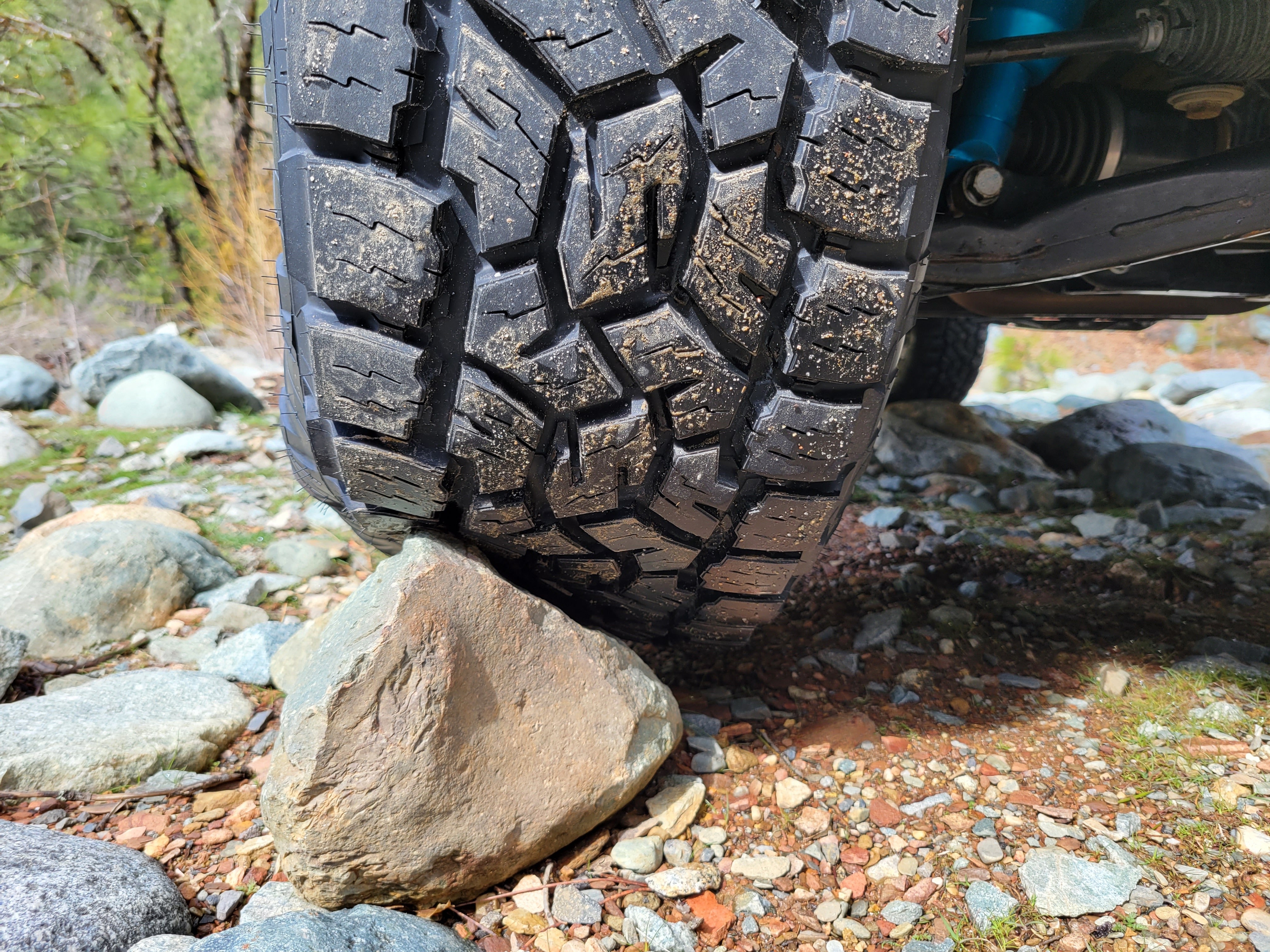
The real test was on Slick Rock Jeep Trail here in California. It’s labeled as Moderate-Difficult 7/10. I’d argue it’s a little more difficult in a long-wheelbase truck on “small” tires. A small group of friends and I hit the trail this summer and once again I was thrilled to not get left behind or hold up the group due to traction issues. The giant granite slabs and huge boulders required careful spotting through climbs, drops, twists and turns but on I went. It wasn’t until I come across a notoriously difficult section of the trail for which I was simply too long and too low to pass through easily.
I managed to climb up onto a ledge, a feat in its own right, but as I crept forward I heard the unmistakable sound of my aluminum driveshaft coming apart and banging around underneath the truck. At that point I knew I was done. I disconnected the driveshaft and got the truck turned around after a good amount of winching and we decided the whole group would make our way back to the trailhead. I was left with only front wheel drive and the occasional tow-strap tug or winch up gnarly rock gardens.
Darkness fell as we neared the trailhead. The last section is somewhat of a “qualifier” in that if it scares you or your vehicle cannot manage it then the trail is too difficult for you. The section was just too steep and too loose for my truck to climb in front wheel drive so we attached a tow strap to a friend’s Jeep and he tugged me through most of the section but without the ability to control my speed or even pick good lines in the darkness I inevitably slammed, really hard, into a boulder with my front passenger-side wheel and tire.
I cringed and waited for the sound of leaking air but none came. I radioed my friend to keep going and moments later we popped out onto the smooth gravel road of the trailhead. I inspected the tire and found a quarter-sized flap opened on the sidewall going nearly to the sidewall threads. In an effort to THOROUGHLY test these tires I decided to skip mounting up a spare and risk making the 3.5hr trek back home late at night. Foolish? Perhaps. But this is a real-life situation and not everyone has a good spare tire or the ability to change it or maybe they don’t even know they damaged the tire.
I made it home safely in 2wd, minus a driveshaft and with a gashed front tire. So what did I do then? I decided I was not going to change it out for the remainder of this review period and see how long it will hold air. Here I am writing this 4 months and many many miles on and off-road later and the tire still holds true. I’ve ran more trails and aired down more times than I care to remember and that damn tire will not die.
This is my long-winded way of telling you to not be discouraged by the 2-ply sidewall rating of this tire. It’s thicker and more robust than the rating would lead you to believe.
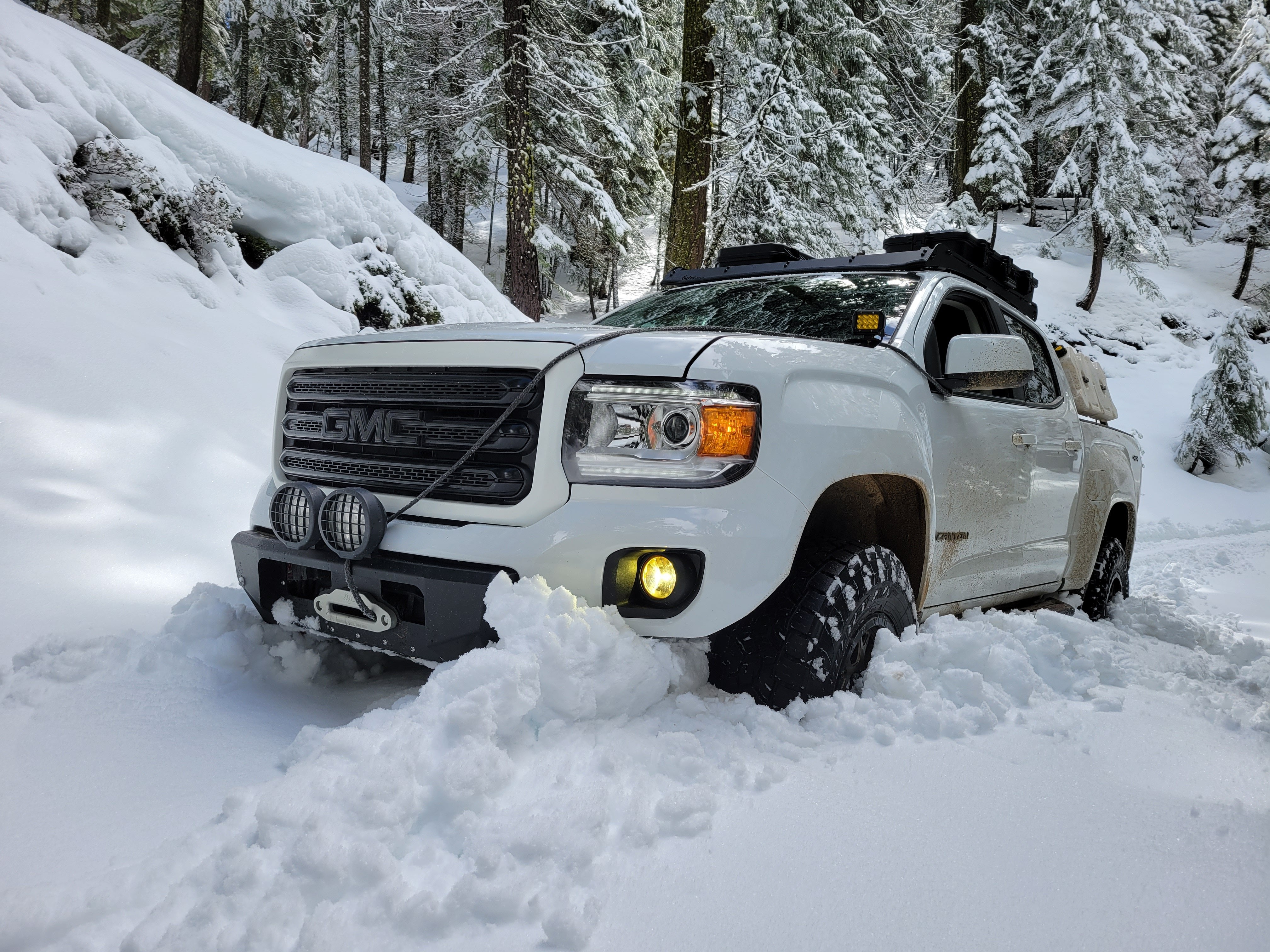
Snow Performance – I’ve almost spent as much time on snow as I have on pavement with these tires. ‘Tis the season for snow-wheeling and snow camping around here so what better way to test the snow and cold weather performance of the Toyo Tires than to hit the snow-covered trails and see if you can get stuck once or twice?
After a dozen trips snow-wheeling I am thoroughly impressed with the traction these tires exhibit on and especially off-road. There are a lot of tires than can drive well in snowy on-road conditions but often fail when driven on deeper snow covered trails where there’s no hope of reaching pavement or anything brown and resembling terra firma. In these situations all you can do is air the tires way down and work your way down the trail slowly with careful throttle input.
The Toyo Open Country A/T III excels in all of the snowy conditions I experienced. The Sierra Nevada region I live in generally receives copious amounts of what we call “Sierra Cement”. It’s a wet, heavy snow that offers little traction and is very difficult to “plow” through. It’s not the light fluffy stuff you see in car commercials where cute little CUVs go blowing through waist deep drifts of snow. As such the key to traveling trails in “Sierra Cement” is floatation and careful throttle application.
Upon leaving pavement I usually drop tire pressure down to between 15psi and 18psi to increase the tires footprint on the snow and hopefully enhance the truck’s ability to float on top of the snow instead of breaking through crust and sinking to the chassis. In the really difficult conditions I even went as low as 10psi and the traction was incredible for an all-terrain tire in these challenging conditions. I even managed to tow fellow drivers up slick slopes after their tires stopped providing traction. Of course I managed to get stuck a time or ten as well but if you’re not pushing the limits you’re not doing it right in my opinion. We always travel with at least one other capable and well equipped rig and as such I was able to push these tires to the very limits in snowy trail conditions and they passed with flying colors.
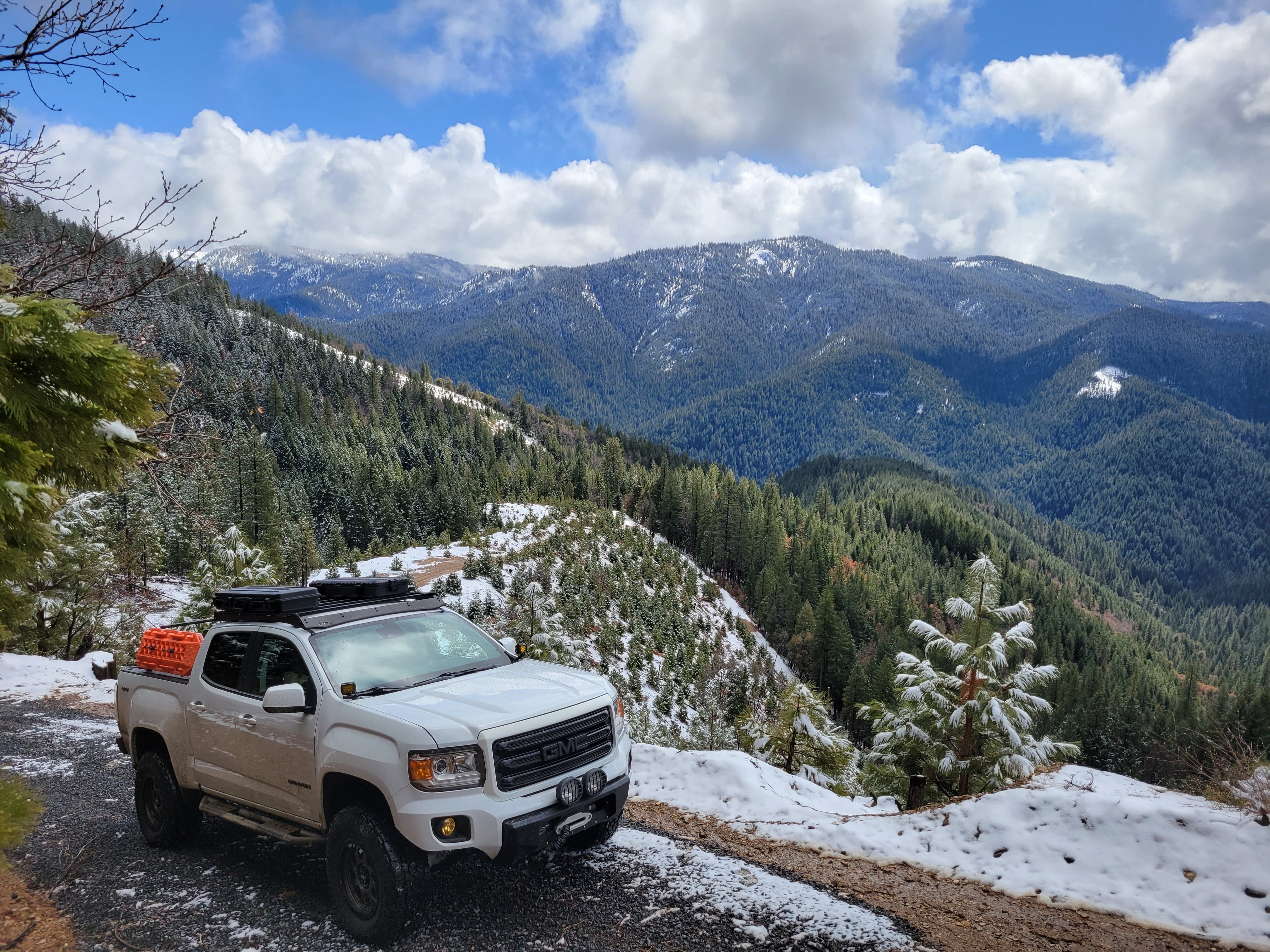
Summary
After roughly 12,000 miles of abuse, tread depth is a uniform 13/32nds to 14/32nds with only a few treadblocks showing any signs of chipping. The sidewalls look like new with exception to the aforementioned casualty of Slick Rock Trail. Road noise remains low and traction is still excellent; good in wet. The Toyo Open Country A/T III tires worked exactly as I had hoped and never let me down. They enabled adventure and they got me home afterwards. What else do you really need from a tire? Would I recommend them to family and friends? You bet! Do I still love them? YES!!!
